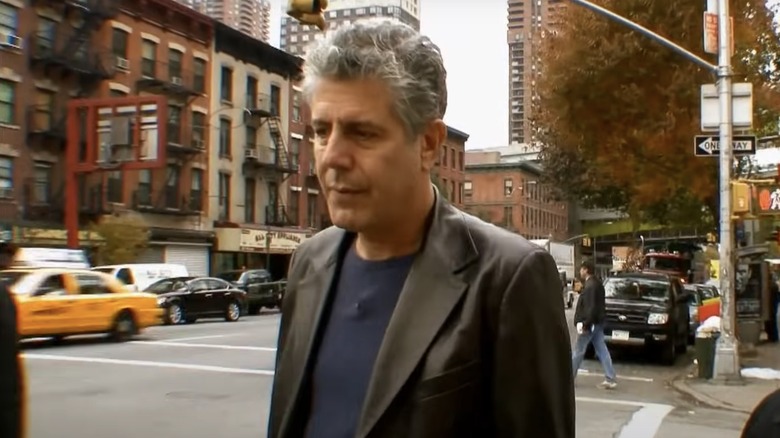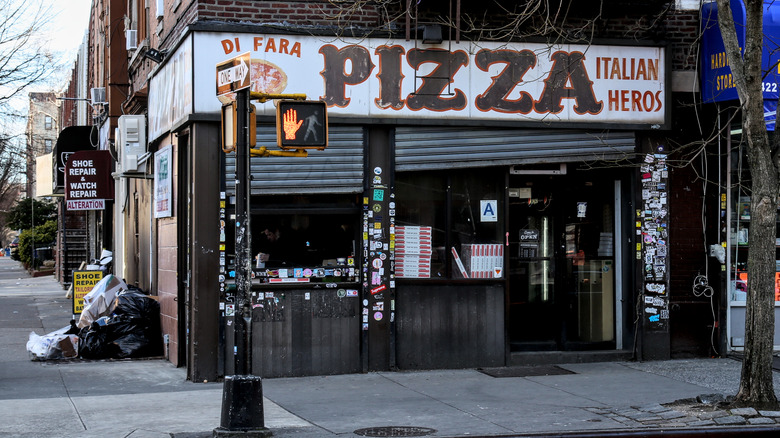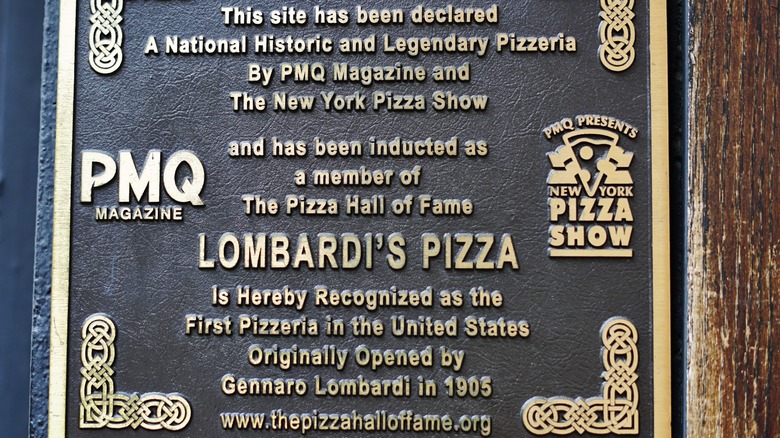This New York City Pizza Spot Was Hailed By Anthony Bourdain As 'The Best Of The Best'
If you're looking for the best pizza in New York City, you could do worse than a recommendation from the late, great Anthony Bourdain. Despite jetting around the world with multiple travel shows, beginning with "A Cook's Tour" in 2002, Bourdain was born in the Big Apple. In his New York Times best-selling book, "Kitchen Confidential: Adventures in the Culinary Underbelly," he wrote of the city's restaurant scene with intimate knowledge. He had gained firsthand experience from a long line of food-service jobs, starting with the Rainbow Room in Rockefeller Center, where you can soar 800 feet above the streets of New York.
This background gave Bourdain more of a local's perspective on New York dining than any other place he visited. Writing in the Guardian, he called his city "the greatest in the world," and said that, when visiting, "one should go for things that we do really well and the rest of the world doesn't." One of those things, according to Bourdain, is foldable, New York-style pizza. "If you feel like humping out to Brooklyn, to DiFara's, you can get the best of the best," he wrote.
The place he was referring to is Di Fara Pizza, which is still around, though Bourdain made his offhand mention of it back in August 2005, just a few weeks after his Travel Channel show, "No Reservations," aired its first episode. Seven years and two Emmy Award wins later, Bourdain chose Brooklyn as the site of his final "No Reservations" episode. When you're there, you can grab a slice at Di Fara Pizza to see if it still measures up as the best all these years later.
Visit Di Fara Pizza for a Bourdain-approved slice
Di Fara Pizza offers standard toppings like sausage and pepperoni and specialty toppings like meatballs, prosciutto, and porcini mushrooms. It's been known to draw long lines, but delivery is an option (maybe to your hotel, if you're lucky). The pizza even ships nationwide, though it comes frozen in dry ice, without the basil leaves that founder Domenico De Marco was known for cutting with scissors, fresh from his own garden.
Born in Italy — from which the restaurant imports some of its ingredients — De Marco established Di Fara Pizza on Avenue J in Brooklyn in 1965. For many years, he was the only person making the pizza, and the restaurant would close when he wasn't working. In the 2010s, it also temporarily closed several times due to health code violations, but it still served "what many consider the best pizza" in town, as The New York Times called it.
It was big news in 2009 when the price of a slice at Di Fara went up to $5, having only risen to $4 a year and a half before that. However, New York Magazine — which later called Di Fara "the holy grail of classic New York-style pizza" — named it one of the city's best food bargains that same year. In 2024, despite 15 years of inflation, the price had mostly leveled out at $6, with a square, Sicilian-style slice fetching $8. De Marco died in 2022, but his legacy is being carried on by his children, including his daughter, Margie De Marco Mieles. In 2023, the restaurant shared an old photo of her with Anthony Bourdain on Instagram.
Bourdain also recommended America's first pizzeria
If you can't make it to Brooklyn, Di Fara isn't the only New York pizzeria Bourdain recommended. In the Guardian, he wrote, "I like the white clam pizza at Lombardi's on Spring Street." That's in Manhattan's Little Italy neighborhood, but aside from its prime location, Lombardi's is in the Pizza Hall of Fame as America's first pizzeria, established in 1905 (a full 60 years before Di Fara).
The restaurant still offers its "famous clam pie" with limited availability, though the clams are so fresh they "may contain shells and sand." In addition, the pizza comes topped with garlic, oregano, Romano cheese, black pepper, and parsley. As Bourdain noted, "They only serve whole pies at Lombardi's," so you won't be able to get pizza by the slice here like you would at Di Fara. However, if your appetite doesn't match the restaurant's historical appeal, you can always go for the personal calzone or another menu item like ravioli or chicken parmigiana.
Per The Philadelphia Inquirer, investigators have alleged that Lombardi's once had mob ties, but that probably wouldn't have fazed Bourdain. He said he liked living in a city "where nearly every street corner" reminded him of "some piece of lurid personal or criminal history," like famous mobsters getting whacked. A lecturer at the U.S. Pizza Museum in Chicago further alleged that Italian immigrant Gennaro Lombardi may have taken Lombardi's over from another owner, Filippo Milone, rather than founding the restaurant himself. Regardless of that, there's only one Chicago deep dish restaurant Bourdain enjoyed. For him, pizza was served better New York-style at places like Lombardi's and Di Fara.


